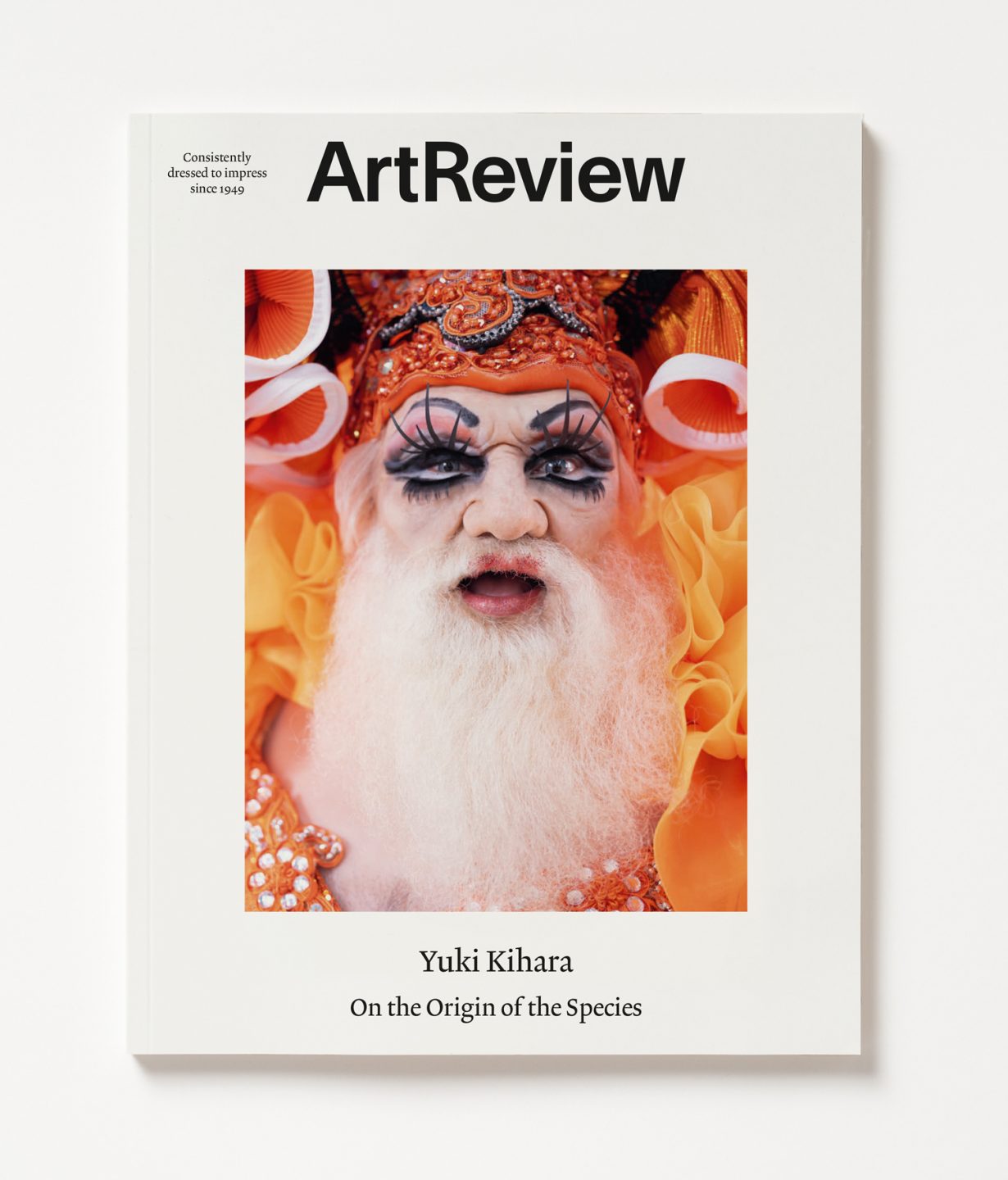
***Subscribe now or get your copy from our new online shop***
The April issue of ArtReview looks at how artists choose to portray themselves and others, and how systems of representation dictate forms of knowledge.
Take Japanese-Sāmoan cover artist Yuki Kihara, whose work dismantles the stereotyping and fetishising Western gaze cast on the bodies and sexuality of Indigenous peoples in the South Pacific. Over two decades, Kihara has used her practice that spans moving image, sculpture, photography, installation and performance, to platform Sāmoa’s Fa’afafine (third gender) community (to which she belongs), while investigating ‘the intersection of gender-based and racial prejudices, resource extraction and the human impact on the environment around the South Seas.’ In her new video Darwin Drag, Kihara confronts the titular biologist’s theory of evolution, which wilfully ignores the existence of non-binary sex traits in animal species. Kihara plays Darwin, who is transformed into a clownfish and taken on an underwater journey through the reefs around Sāmoa by his drag queen-cum-fairy fishmother BUCKWHEAT. During this drag-documentary set to a disco soundtrack, they flirtatiously inform viewers about the variety of non-binary sex traits that can be found in fish species, using this format to challenge imperial systems of knowledge. ‘And, let’s face it’, writes Fi Churchman, ‘it’s also fun to see the hoary-haired biologist… wiggle around in a dazzling sequined dress white batting his eyelashes at his fish friends’.
Tom Seymour, on the other hand, investigates the renaissance of body horror in the age of AI-generated aesthetics. ‘Body horror has historically externalised cultural fears through grotesque transformations of the human form,’ he argues. ‘Today our anxieties are embodied in the convergence of flesh and machine, in genetic manipulation and, postpandemic, in the liminality of human-animal hybridity.’ Exploring films like Coralie Fargeat’s The Substance and Max Minghella’s Shell, as well as works by contemporary artists like Mire Lee’s Open Wound (2024) and Lu Yang’s DOKU series (2022–), Seymour discusses how the human body, whether physical or digital, is, as ever, a malleable form that’s susceptible to artificially generated, genetically engineered and or socially constructed modifications. But, writes Seymour, ‘the horror lies not in the loss of bodily control, but in the realisation that selfhood no longer need be embodied’.
Gabrielle Goliath’s multimedia works, meanwhile, present ways ‘to speak against racialised, sexualised and gendered violence without traumatising, fetishising or objectifying survivors’, writes Stephanie Bailey. The South African artist’s video installations combine performance and testimony to create moving portraits of collective mourning and offer a reckoning for victims of domestic abuse, femicide and survivors of rape. Through sustained, sung notes or the recording of nonverbal utterances, Goliath tests ‘how art can create space for trauma to unfold and unfurl’, bearing witness to ‘the complex web of emotions and states that define its ever-shifting and far-reaching textures, both within the body and without.’
Also in this issue, Yuwen Jiang interviews theorist, filmmaker, curator and author Ariella Aïsha Azoulay about her recent and upcoming projects focusing on the ummah, or the global Muslim community, a commonwealth in which Jews were once protected under Islamic laws, and the challenge of making a Jewish-Muslim world imaginable again. They discuss the politics of looking and ways to unlearn colonial modes of thinking. Elsewhere, Jiang and Mark Rappolt annotate an excerpt from Japanese scholar and art critic Okakura Tenshin’s Ideals of the East: With Special Reference to the Art of Japan (1903); Martin Herbert detects a trend in either producing extremely figurative art, or extremely abstract art, proving again that the artworld is everybody and nobody; Chris Fite-Wassilak observes that culinary experiences in exhibitions are on the rise, but questions why food needs to be framed as ‘art’ in order to be considered something special; Phoebe Blatton wonders what balance of the expected and unexpected will bring crowds through Warsaw’s newly relocated Museum of Modern Art’s doors; J.J. Charlesworth argues that the artworld will have to work hard to regain its legitimacy after Trump’s second coming; and artist David Salle considers the ideal curriculum for training an AI artist.
Plus, reviews of books and exhibitions around the world, including Christine Sun Kim at the Whitney Museum of American Art, New York; Wafaa Bilal at MCA, Chicago; Carolina Fusilier & Paloma Contreras Lomas at Museo Anahuacalli, Mexico City; Efo Sela at Nubuke Foundation, Accra; Carole Bove at Musée d’Art et d’Histoire, Geneva; and much more
***Subscribe now or get your copy from our new online shop***